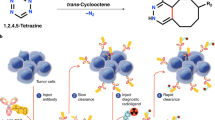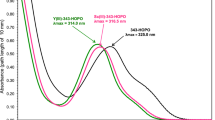Abstract
The number of radiopharmaceuticals containing copper radionuclides for diagnostic imaging and targeted radiotherapy has grown considerably over the past few decades. This expansion has created the need for protocols allowing for the efficient chelation of 64Cu to peptide-chelator conjugates. Step 1A of this protocol describes a 64Cu-radiolabeling procedure for 1,4,8,11-tetraazacyclododecane-1,4,8,11-tetraacetic acid (TETA)-conjugated peptides. This reaction is facile and requires the incubation of 64CuCl2 in 0.1 M ammonium acetate buffer with the TETA-peptide for 30 min at room temperature (20–23 °C). Step 1B of this protocol describes the radiolabeling procedure for 4,11-bis(carboxymethyl)-1,4,8,11-tetraazabicyclo[6.6.2]hexadecane (CB-TE2A)-conjugated peptides. The CB-TE2A-peptide can be labeled with 64Cu in 0.1 M ammonium acetate buffer in 2 h at 95 °C. In both cases, the conjugates can be radiolabeled with 64Cu at greater than 95% purity and with specific activities of 37–111 MBq μg−1 (1–3 mCi μg−1). Both protocols are straightforward and can be completed within 3 h.
This is a preview of subscription content, access via your institution
Access options
Subscribe to this journal
Receive 12 print issues and online access
$259.00 per year
only $21.58 per issue
Buy this article
- Purchase on Springer Link
- Instant access to full article PDF
Prices may be subject to local taxes which are calculated during checkout



Similar content being viewed by others
References
Wadas, T.J., Wong, E.H., Weisman, G.R. & Anderson, C.J. Copper chelation chemistry and its role in copper radiopharmaceuticals. Curr. Pharm. Des. (in the press).
Smith, S.V. Molecular imaging with copper-64. J. Inorg. Biochem. 98, 1874–1901 (2004).
Mountz John, D. et al. Molecular imaging: new applications for biochemistry. J. Cell. Biochem. Suppl. 39, 162–171 (2002).
Rowland, D.J., Lewis, J.S. & Welch, M.J. Molecular imaging: the application of small animal positron emission tomography. J. Cell. Biochem. Suppl. 39, 110–115 (2002).
Blok, D., Feitsma, R.I.J., Vermeij, P. & Pauwels, E.J.K. Peptide radiopharmaceuticals in nuclear medicine. Eur. J. Nucl. Med. 26, 1511–1519 (1999).
Okarvi, S.M. Recent progress in fluorine-18 labelled peptide radiopharmaceuticals. Eur. J. Nucl. Med. 28, 928–938 (2001).
Signore, A. et al. Peptide radiopharmaceuticals for diagnosis and therapy. Eur. J. Nucl. Med. 28, 1555–1565 (2001).
Sun, X. & Anderson, C.J. Production and applications of copper-64 radiopharmaceuticals. Meth. Enzymol. 386, 237–261 (2004).
Anderson, C.J. & Welch, M.J. Radiometal-labeled agents (non-technetium) for diagnostic imaging. Chem. Rev. 99, 2219–2234 (1999).
Blower, P.J., Lewis, J.S. & Zweit, J. Copper radionuclides and radiopharmaceuticals in nuclear medicine. Nucl. Med. Biol. 23, 957–980 (1996).
Hnatowich, D.J., Layne, W.W., Childs, R.L., Lanteigne, D. & Davis, M.A. Radioactive labeling of antibody: a simple and efficient method. Science 220, 613–615 (1983).
Parker, D., Morphy, J.R., Jankowski, K. & Cox, J. Implementation of macrocycle-conjugated antibodies for tumor-targeting. Pure Appl. Chem. 61 (9): 1637–1641 (1990).
Cole, W.C. et al. Serum stability of 67Cu chelates: comparison with 111In and 57Co. Nucl. Med. Biol. 13, 363–368 (1986).
Yeh, S.M., Sherman, D.G. & Meares, C.F. A new route to 'bifunctional' chelating agents: conversion of amino acids to analogs of ethylenedinitrilotetraacetic acid. Anal. Biochem. 100, 152–159 (1979).
Meares, C.F. & Wensel, T.G. Metal chelates as probes of biological systems. Acc. Chem. Res. 17, 202–209 (1984).
Moi, M.K., Meares, C.F., McCall, M.J., Cole, W.C. & DeNardo, S.J. Copper chelates as probes of biological systems: stable copper complexes with a macrocyclic bifunctional chelating agent. Anal. Biochem. 148, 249–253 (1985).
Cole, W.C. et al. Comparative serum stability of radiochelates for antibody radiopharmaceuticals. J. Nucl. Med. 28, 83–90 (1987).
Meares, C.F. et al. Macrocyclic chelates of radiometals for diagnosis and therapy. Br. J. Cancer Suppl. 10, 21–26 (1990).
Kukis, D.L., Li, M. & Meares, C.F. Selectivity of antibody-chelate conjugates for binding copper in the presence of competing metals. Inorg. Chem. 32, 3981–3982 (1993).
Wu, Y. et al. MicroPET imaging of glioma integrin αvβ3 expression using (64)Cu-labeled tetrameric RGD peptide. J. Nucl. Med. 46, 1707–1718 (2005).
Li, W.P., Lewis, J.S., Srinivasan, A., Schmidt, M.A. & Anderson, C.J. Copper-64/61 and iodine-125-labeled DOTA-D-TYR1-octreotate: a new somatostatin analog for labeling with metals and halogens. J. Labelled Comp. Radiopharm. 44 (suppl 1): S948–S950 (2001).
McQuade, P. et al. Imaging of melanoma using 64Cu- and 86Y-DOTA-ReCCMSH(Arg11), a cyclized peptide analogue of α-MSH. J. Med. Chem. 48, 2985–2992 (2005).
Chen, X. et al. Integrin αvβ3-targeted imaging of lung cancer. Neoplasia 7, 271–279 (2005).
Chen, X. et al. MicroPET and autoradiographic imaging of breast cancer αvβ3 integrin expression using F-18 and Cu-64-labeled RGD peptides. Bioconjug. Chem. 15, 41–49 (2004).
Chen, X. et al. Pegylated Arg-Gly-Asp peptide: 64Cu labeling and PET imaging of brain tumor αvβ3-integrin expression. J. Nucl. Med. 45, 1776–1783 (2004).
Anderson, C.J. et al. Preparation, biodistribution and dosimetry of copper-64-labeled anti-colorectal carcinoma monoclonal antibody fragments 1A3-F(ab′)2 . J. Nucl. Med. 36, 850–858 (1995).
Anderson, C.J. et al. Radiotherapy, toxicity and dosimetry of copper-64-TETA-octreotide in tumor-bearing rats. J. Nucl. Med. 39, 1944–1951 (1998).
Anderson, C.J. et al. Copper-64-TETA-octreotide as a PET imaging agent for patients with neuroendocrine tumors. J. Nucl. Med. 42, 213–221 (2001).
Lewis, J.S., Srinivasan, A., Schmidt, M.A. & Anderson, C.J. In vitro and in vivo evaluation of 64Cu-TETA-Tyr3-octreotate. A new somatostatin analog with improved target tissue uptake. Nucl. Med. Biol. 26, 267–273 (1998).
Lewis, J.S. et al. Comparison of four 64Cu-labeled somatostatin analogs in vitro and in a tumor-bearing rat model: evaluation of new derivatives for PET imaging and targeted radiotherapy. J. Med. Chem. 42, 1341–1347 (1999).
Lewis, M.R. et al. Conjugation of monoclonal antibodies with TETA using activated esters: biological comparison of 64Cu-TETA-1A3 with 64Cu-BAT-2IT-1A3. Cancer Biother. Radiopharm. 16, 483–494 (2001).
Cutler, P.D. et al. Dosimetry of copper-64-labeled monoclonal antibody 1A3 as determined by PET imaging of the torso. J. Nucl. Med. 36, 2363–2371 (1995).
Wang, M. et al. Subcellular localization of somatostatin analogues: implications for targeted radiotherapy of cancer. Cancer Res. 63, 6864–6869 (2003).
Edwards, W.B., Anderson, C.J., Fields, G.B. & Welch, M.J. Evaluation of type IV collagen fragments as potential tumor imaging agents. Bioconjug. Chem. 12, 1057–1065 (2001).
Weisman, G.R., Rogers, M.E., Wong, E.H., Jasinski, J.P. & Paight, E.S. Cross-bridged cyclam. Protonation and Li+ complexation in a diamond-lattice cleft. J. Am. Chem. Soc. 112, 8604–8605 (1990).
Weisman, G.R. et al. Synthesis and transition-metal complexes of new cross-bridged tetraamine ligands. J. Chem. Soc. Chem. Commun., 947–948.
Niu, W. et al. Copper(II) and zinc(II) complexes of amide pendant-armed cross-bridged tetraamine ligands. Polyhedron 23, 1019–1025 (2004).
Wong, E.H. et al. Synthesis and characterization of cross-bridged cyclams and pendant-armed derivatives and structural studies of their copper(II) complexes. J. Am. Chem. Soc. 122, 10561–10572 (2000).
Woodin, K.S. et al. Kinetic inertness and electrochemical behavior of copper(II) tetraazamacrocyclic complexes: possible implications for in vivo stability. Eur. J. Inorg. Chem. 23, 4829–4833 (2005).
Boswell, C.A. et al. Comparative in vivo stability of copper-64-labeled cross-bridged and conventional tetraazamacrocyclic complexes. J. Med. Chem. 47, 1465–1474 (2004).
Sun, X. et al. Radiolabeling and in vivo behavior of copper-64-labeled cross-bridged cyclam ligands. J. Med. Chem. 45, 469–477 (2002).
Sprague, J.E. et al. Preparation and biological evaluation of copper-64-labeled Tyr3-octreotate using a cross-bridged macrocyclic chelator. Clin. Cancer Res. 10, 8674–8682 (2004).
Wadas, T.J., Wong, E.H., Weisman, G.R. & Anderson, C.J. Copper chelation chemistry and its role in copper radiopharmaceuticals. Curr. Pharm. Design 13, 3–16 (2007).
Edwards, W.B. Cancer Imaging with PET. Ph.D. Thesis, Washington University in St. Louis (1999).
Mant, C.T. & Hodges, R.S. High-Performance Liquid Chromatography of Peptides and Proteins: Separation, Analysis, and Conformation (CRC Press, Boca Raton, Florida, 2000).
Acknowledgements
The authors gratefully acknowledge NIH grants R01 CA93375 (C.J.A.), R01 CA064475 (C.J.A.) and F32 CA115148 (T.J.W.). The production of 64Cu at Washington University School of Medicine has been supported by the NCI grant R24 CA86307.
Author information
Authors and Affiliations
Corresponding author
Ethics declarations
Competing interests
The authors declare no competing financial interests.
Rights and permissions
About this article
Cite this article
Wadas, T., Anderson, C. Radiolabeling of TETA- and CB-TE2A-conjugated peptides with copper-64. Nat Protoc 1, 3062–3068 (2006). https://doi.org/10.1038/nprot.2006.431
Published:
Issue Date:
DOI: https://doi.org/10.1038/nprot.2006.431
This article is cited by
-
Synthesis of DOTA-pyridine chelates for 64Cu coordination and radiolabeling of αMSH peptide
EJNMMI Radiopharmacy and Chemistry (2021)
-
A novel, chelator-free method for 64Cu labeling of dendrimers
Journal of Nanoparticle Research (2018)
-
Preparation, crystal structures and magnetic properties of hetero- and homo-metallic coordination polymers with triazacyclononane derivatives bearing propionic acid pendant arms
Transition Metal Chemistry (2017)
-
Adenoviral-mediated imaging of gene transfer using a somatostatin receptor-cytosine deaminase fusion protein
Cancer Gene Therapy (2015)
-
A Physiological Perspective on the Use of Imaging to Assess the In Vivo Delivery of Therapeutics
Annals of Biomedical Engineering (2014)
Comments
By submitting a comment you agree to abide by our Terms and Community Guidelines. If you find something abusive or that does not comply with our terms or guidelines please flag it as inappropriate.



